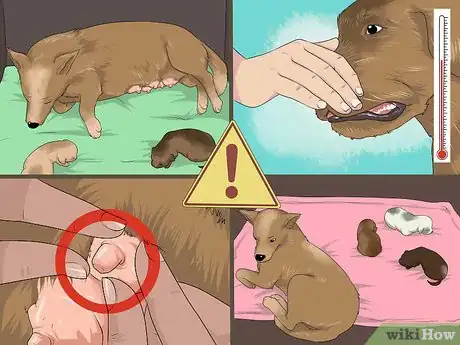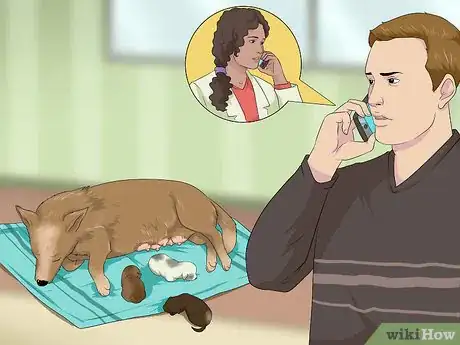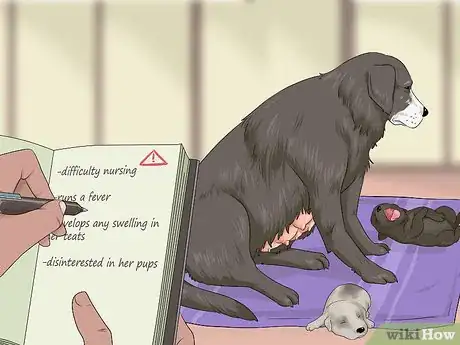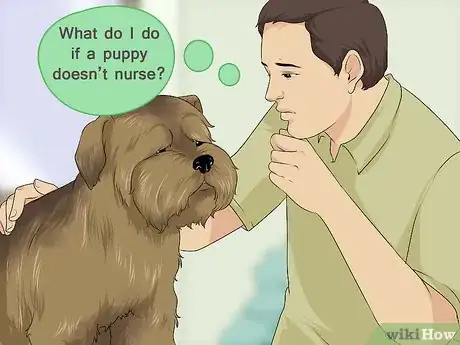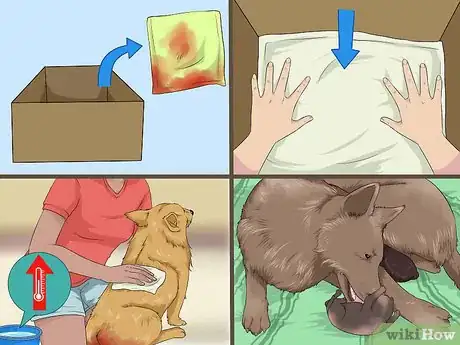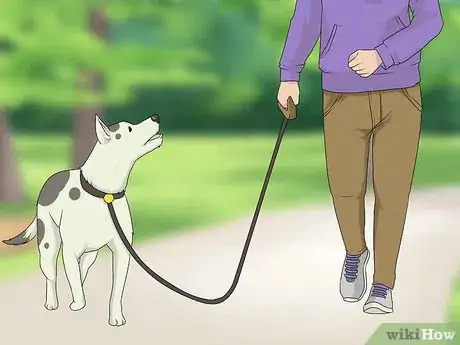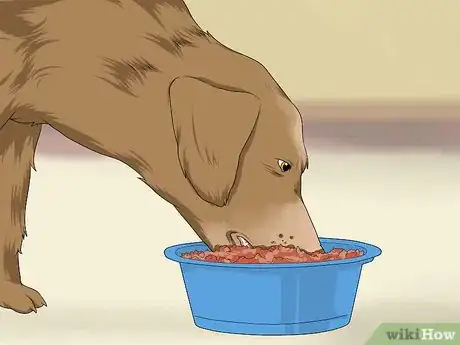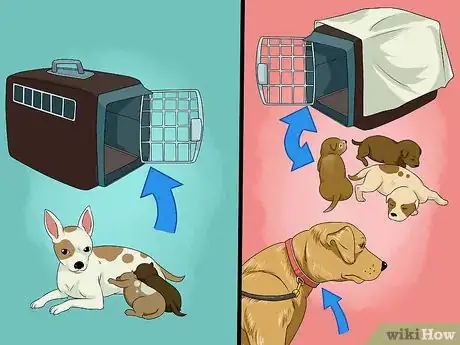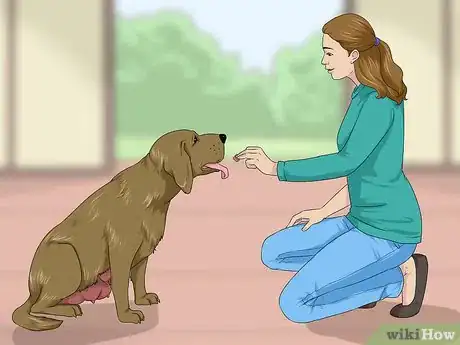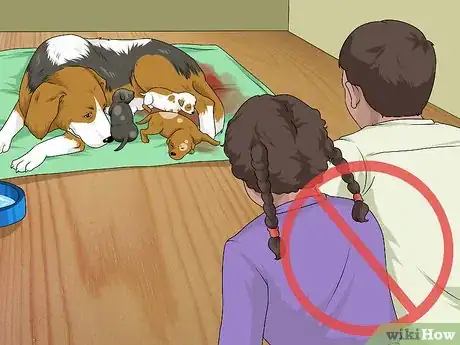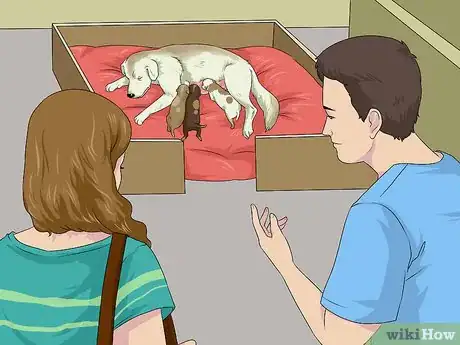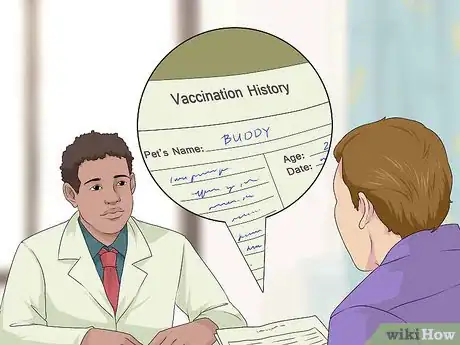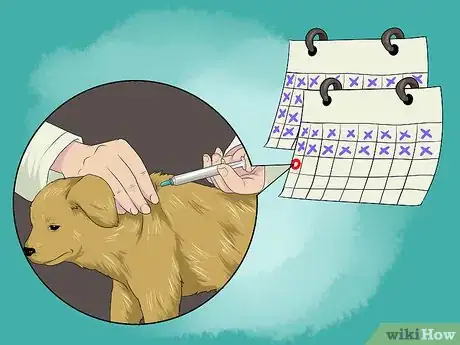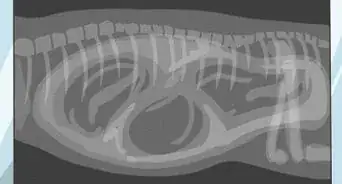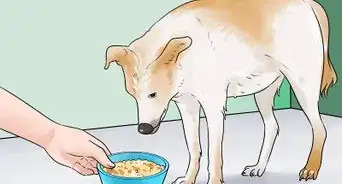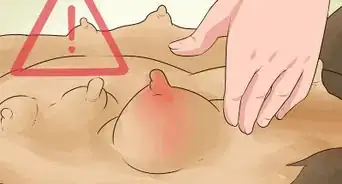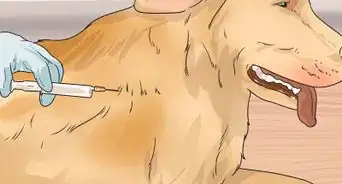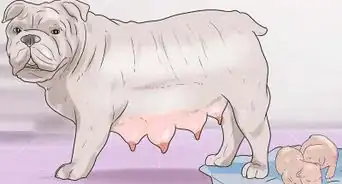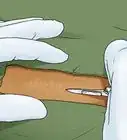This article was co-authored by Melissa Nelson, DVM, PhD. Dr. Nelson is a Veterinarian who specializes in Companion and Large Animal Medicine in Minnesota, where she has over 18 years of experience as a veterinarian in a rural clinic. She received her Doctor of Veterinary Medicine from the University of Minnesota in 1998.
There are 8 references cited in this article, which can be found at the bottom of the page.
This article has been viewed 18,677 times.
After your mother dog delivers her puppies, you should take the mother and her pups to the veterinarian for a postnatal checkup. You will want to first call your veterinarian, schedule an appointment, and be sure to note any problems your pets are having. You will also want to clean up the mother dog and make sure that she is healthy enough for a visit. If the mother and pups are healthy enough to travel, it is important that you manage your dog’s behavior at the vet’s office by keeping your dog on a leash and your pups in a box or carrier. Finally, in order to have a productive visit, you should ask the veterinarian questions and come prepared to schedule future checkups.
Steps
Making Arrangements for the Visit
-
1Check on the mother and her puppies regularly. For the first week, check at least twice a day to make sure that your dog is recovering and that the puppies are doing well.
- Monitor your mother dog's vaginal discharge post-whelping.
- Take your dog's temperature to make sure that she doesn't spike a fever. A high temperature for a dog is a temperature over 102.5 degrees Fahrenheit. You can take your dog's temperature either rectally with a mercury thermometer or in your dog's ear with an ear thermometer.
- Weigh the puppies every day, and track their weights to make sure that they gain every day. You will need to find a way to distinguish the puppies from each other if they look similar to each other. It's important that you know if one of the puppies is not gaining.
-
2Recognize the signs of immediate danger. There are certain symptoms that, if exhibited by the mother dog or pups, may require the immediate attention of a veterinarian. If the mother dog has difficulty nursing, runs a fever, develops any swelling or tenderness in her teats, or generally seems disinterested in her pups, you should seek veterinary assistance immediately. If the pups struggle to gain weight, fail to nurse properly, or die, you should also visit a veterinarian as soon as possible. To save the life of your dog and the pups, prompt action is essential.[1]
- It is important that you are able to recognize the symptoms of Eclampsia (milk fever), metritis, and mastitis in your mother dog.
- Eclampsia occurs when a mother dog's calcium is low and usually happens in small dogs. Symptoms include stiff gait, trouble standing, restlessness, pacing, panting, fever, muscle spasms, seizures, and lack of interest in her puppies.
- Metritis is usually caused by after-birth or a stillborn puppy that remains in the mother dog. Symptoms include fever, lethargy, lack of appetite, smelly discharge, fast heart rate, dehydration, panting, vomiting, and diarrhea.
- Mastitis is an infection in the dog's mammary glands. Symptoms include red, hot, inflamed nipples.[2]
- You should also be sure to deal with nipple guarding among your puppies, which can lead to fading puppy syndrome and death.
Advertisement -
3Make the appointment. Once the mother dog has delivered her pups, you will want to contact your vet to schedule a visit. If the birth normal and all of the animals are healthy, you should have a postpartum checkup 24 to 48 hours after the delivery of the pups. You will also want to schedule an appointment for the veterinarian to examine your dog and the puppies at the same time.[3]
- Because you want to avoid the risk of infection with your newborn pups and the mother, ask if the veterinarian will make a home visit. Although it may cost extra, it prevents you from risking the health of your dog and pups.
- Be clear with the clinic staff about why you are bringing your dog, especially if the mother or pups are experiencing any postpartum complications, such as eclampsia, metritis, or mastitis. Say, "My dog recently gave birth, and I need to have her evaluated to make sure that she is recovering well. I also want to have the puppies checked. Her temperature has peaked at 102 degrees Fahrenheit, so she appears to be doing well. However, one of the puppies is struggling to gain weight."
-
4Take notes about your pet’s condition. Before you go to the veterinarian, write down the condition of the mother and the pups. Try to be as detailed as possible when describing any problems that you notice. This will help the veterinarian get a better idea of what potential complications may arise.
- Detailed notes can help your veterinarian diagnose things like fading puppy syndrome in the pups or mastitis in the mother.
-
5Think about what you should ask the vet. Before the appointment, make a list of questions that you would like the veterinarian to answer. This will help you avoid forgetting any important questions about your animals’ health. Since you will be taking the mother and the pups, try to think of questions for both.
- You might ask things like “What do I do if a puppy doesn’t nurse?” “What do I do if the mother does not produce enough milk?” "What do I do if the mother refuses to nurse the puppies?" "What can I do if a puppy prevents other puppies from nursing?" "What is normal behavior for a postnatal dog?" "How often should the puppies nurse?" and "When should I call for an appointment?"
Preparing Your Pets
-
1Groom the mother. After the mother gives birth, it is important that you clean her. Remove any soiled materials from the whelping box to keep the mother and pups sanitary and fresh. Gently clean the mother with a warm damp cloth, washing away any fecal matter, blood, or other bodily fluids and tissues. Besides being sanitary, cleaning your dog before the visit will also make it easier for the veterinarian to assess your animal’s health.
- You should not clean the pups. The mother will do that and it is an important part of the bonding process. Wait until your dog has cleaned her puppies, and then throw out the soiled bedding. Replace it with clean bedding.
-
2Walk the mother. Although it is unlikely that your new mother will be particularly energetic after giving birth, it may be a good idea to take her for a walk if she has the energy. This will help her stay calm during your visit to the veterinarian and will give her a chance to urinate and defecate. However, if the mother is weak, do not push her physically.[4]
-
3Feed the mother normally. Although it is sometimes advised to not feed your dog before going to the veterinarian, you should continue feeding the nursing mother dog regularly, regardless of the vet visit. Limiting the mother’s caloric intake during nursing will place an immense strain on her body. This could cause her to become ill or limit her milk production. For the health of the mother and the pups, make sure you continue to feed her normally.
- Because of the demands of nursing, the mother will likely eat much more than she did before the delivery. Ask your vet how much and what kind of food to feed your dog.
Managing Your Dog’s Behavior at the Visit
-
1Restrain the animals. If your dog is small enough, consider keeping it in a carrier with its pups. This will help keep it calm and prevent it from getting combative with any other pets. If your dog is too big for a carrier, keep it on a leash. Keep the puppies in a box, bin, or carrier for their protection and cover it with a blanket to keep them calm.[5]
- A carrier may also make it easier to transport your dog and pups to the veterinarian.
- Because the mother dog will be protective of her puppies, she may need to be removed during the check-up while the vet is handling the pups. If you can, have another adult attend the visit with you who can sit with your dog.
-
2Bring treats. During the visit, you should bring treats in order to reward your dog for good behavior. This will help you manage the mother’s behavior while she is in a particularly stressful situation. The veterinarian will also likely give the dog some treats during the checkup.
- You may also want to bring along one of your dog’s favorite toys to play with.
-
3Minimize distractions. When you take the dogs to the veterinarian, try to limit the number of distractions your mother and pups encounter. If you have children, leave them at home. They may excite your mother dog or the cause the pups to become agitated. It may also be best to schedule a time to go to the veterinarian when it will not be too busy. A weekday morning or afternoon might be the ideal time to take the new mother and her pups to the vet.[6]
- It is important to keep the pups calm. Once they begin to cry, the mother will become anxious and agitated.
- Because it may be nearly impossible to avoid distractions, it may be easier to ask your veterinarian to make a house call.
Having a Productive Exam
-
1Get to your appointment on time. Try to be punctual for your appointment. Your dog will notice your stress if you are running late, which will increase its anxiety. However, you do not want to be too early and sit in the waiting room for an extended amount of time. This increases the likelihood that your vulnerable animals will catch some illness at the vet’s office.
- Try to get the clinic 10 to 15 minutes before your appointment.
-
2Bring your dog’s medical records. When you get to the veterinarian, make sure that you have your dog’s full health records. This includes all of its immunizations and past medical conditions. You should also be prepared to explain your dog’s diet. This is particularly important for gauging the health of your nursing mother dog.[7]
- You should also let the staff know if your dog has a history of being aggressive. If your dog is aggressive, she may need to be restrained and/or muzzled.
-
3Ask questions. While the veterinarian is examining your animal, you should ask questions about the health of the mother and the pups. This is the time to bring out the list of questions that you wrote earlier. You should also ask the veterinarian questions in the moment and respond to their inquiries about the delivery and the health of the animals.[8]
- Ask things like “When should I get the pups vaccinated?” “When should I spay the mother dog?” "How can I keep the puppies healthy?" "When should I start transitioning the puppies to puppy food?" "What kind of puppy food should I feed them?" "Does my mother dog require additional walks?" and "How can I keep my dog's nipples healthy?"
-
4Arrange follow-up visits. After the visit, you should arrange for follow-up visits. If your animals are in poor health, your vet may want to do a follow-up to see how they are doing. Your puppies will also need to get a series of vaccinations once they reach 6 weeks. In addition, unless you are a professional breeder, you will likely want to arrange to get the mother dog spayed. Talk with the veterinarian and the clinic staff about scheduling these appointments.[9]
- Once your puppies reach 6 weeks, it is important that you get them immunized. A puppy’s immune system is particularly weak and vulnerable to a number of dangerous illnesses.
-
5Know how to give your dog any treatments that are prescribed. If your vet does give your dog a medication, ask them how to administer it and how it will affect your dog. Find out when you should call the vet if you're having trouble getting your dog to take the medication and what side effects you should watch for.
- Ask "What's the best way to get my dog to take her medicine?" "How do I know that my dog's condition is worsening instead of improving?" and "Can my dog still nurse while she's taking the medication?"
- Ask when to come in for a follow-up exam.
References
- ↑ https://pethelpful.com/dogs/Dog-Health-Common-Complication-in-Dogs-After-Giving-Birth
- ↑ https://pethelpful.com/dogs/Dog-Problems-After-Giving-Birth
- ↑ http://www.vcahospitals.com/main/pet-health-information/article/animal-health/breeding-for-dog-owners-caring-for-newborn-puppies/488
- ↑ http://www.hillspet.com/en/us/dog-care/routine-care/taking-your-dog-to-the-vet
- ↑ http://www.hillspet.com/en/us/dog-care/routine-care/taking-your-dog-to-the-vet
- ↑ http://www.vetstreet.com/our-pet-experts/the-7-things-pet-owners-do-that-drive-veterinarians-crazy
- ↑ http://thebark.com/content/ten-commandments-veterinary-office-visits
- ↑ http://thebark.com/content/ten-commandments-veterinary-office-visits
- ↑ http://www.akc.org/content/health/articles/puppy-shots-complete-guide/
About This Article
Take your mother dog to a postnatal veterinary exam right away if it has difficulty nursing, runs a fever, has swollen teats, or if it’s disinterested in its puppies, since it may be a medical emergency. Otherwise, if mother and puppies seem healthy, you can schedule the exam for 24-48 hours after the delivery. You may want to ask your vet if they do home visits, since taking your mother dog outside soon after delivery can risk infecting it as well as the puppies. During your appointment, make sure to ask the vet any questions you have about caring for the mother and its puppies. For example, you might ask “What do I do if a puppy doesn’t nurse?” or “What should I do if the mother refuses to nurse?” To learn how to care for your mother dog after delivery, read more from our Veterinary co-author.
